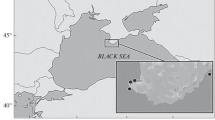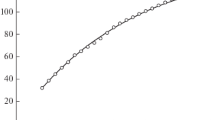Abstract
Growth is known to be one of the key parameters in animal ecology. The rates and periodicity of growth are determined by the internal physiological characteristics of species and the external conditions of their habitat. The growth rates and their features were studied using Ophiacantha bidentata as an example. This species is widely distributed in the Arctic. The collection material of the Marine Research Laboratory, Zoological Institute, Russian Academy of Sciences, was used for this study. The samples of O. bidentata were analyzed from two regions of the Russian Arctic: Vikhr Strait (Franz Josef Land) and Vilkitsky Strait. The determination of the individual age was performed by counting the ring-shaped growth marks in the calcite structure of the radial vertebrae of the animal. Each visible ring was considered as annual. The Gompertz equation was used as the basic mathematical model to describe the growth of this species. In Vikhr Strait, the average value of the theoretically limit radius of the arm (R∞) of O. bidentata was 399 ± 28 μm, and the exponential deceleration of the specific growth rate (g) was 0.58 ± 0.028. The parameters of group growth differed from that mentioned above and were R∞ = 476 ± 28 μm, g = 0.39 ± 0.063. Similar calculations performed for the O. bidentata population from the Vilkitsky Strait showed that the average value of the theoretically limit radius of the arm was 398 ± 25 μm, the exponential deceleration of the specific growth rate was 0.39 ± 0.018, and the parameters of group growth were as follows: R∞ = 495 ± 23 µm, g = 0.26 ± 0.028. The maximum lifespan of O. bidentata in the study population from Vikhr Strait (Franz Josef Land) was estimated to last 7–10 years versus 10–15 years for the Vilkitsky Strait population.








Similar content being viewed by others
REFERENCES
Alimov A.F., Kazantseva T.I., The main quantitative characteristics of populations and the relationship between them, Zh. Obshch. Biol., 2004, vol. 65, no, pp. 3–18.
Anisimova N.A., Ecology of mass species of echinoderms, in Sovremennyi bentos Barentseva i Karskogo morya (Modern Benthos of the Barents and Kara Seas), Apatity: KNTs Ross. Akad. Nauk, 2000, pp. 275–300.
Chuchukalo, V.I. and Napakazov, V.V., On the methodology for determining the daily diet and the rate of food digestion in predatory and benthos-eating fishes, Izv. TINRO, 1999, vol. 126, pp. 160–171.
Chuchukalo, V.I., Nadtochii, V.A., Koblikov, V.N., and Borilko, O.Yu., Feeding and some features of the ecology of mass commercial species of crabs in the waters of the northwestern part of the Sea of Japan in the early spring period, Izv. TINRO, 2011, vol. 166, pp. 123–137.
Dahm, C., Growth, production and ecological significance of Ophiura albida and O. ophiura (Echinodermata: Ophiuroidea) in the German Bight, Mar. Biol., 1993, vol. 116, no. 3, pp. 431–437.
Dahm, C., Ophiuroids (Echinodermata) of Southern Chile and the Antarctic: taxonomy, biomass, diet and growth of dominant species, Scientia Marina, 1999, vol. 63, no.1, pp. 427–432.
Dahm, C. and Brey, T., Determination of growth and age of slow growing brittle stars (Echinodermata: Ophiuroidea) from natural growth bands, J. Mar. Biol. Assoc. U. K., 1998, vol. 78, no.3, pp. 941–951.
Denisenko, S.G., Ekologiya i resursy islandskogo grebeshka v Barentsevom more (Ecology and Resources of the Icelandic Scallop in the Barents Sea), Apatity: KNTs Ross. Akad. Nauk, 1989.
Gage, J.D., Skeletal growth bands in sea brittle stars: microstructure and significance as age markers, J. Mar. Biol. Assoc. U. K., 1990, vol. 70, no.1, pp. 209–224.
Gage, J.D., Skeletal growth markers in the deep-sea brittle stars Ophiura ljungmani and Ophiomusium lymani, Mar. Biol., 1990a, vol. 104, no.3, pp. 427–435.
Golikov, A.N. and Averintsev, V.G., Biocenoses of the upper shelf of the Franz Josef Land archipelago and some regularities of their distribution, in Biotsenozy shel’fa Zemli Frantsa-Iosifa i fauna sopredel’nykh akvatorii (Biocenoses of the Franz Josef Land Shelf and Fauna of Adjacent Water Areas), Issled. Fauny Morei, 1977, vol. XIV (XXII), pp. 5–54.
Komarova, I.V., Feeding of the ruff flounder (Hipoglossoides platessoides) in the Barents Sea in connection with forage resources, Tr. VNIRKhO, 1939, vol. IV, pp. 297–320.
Litvinova, N.M., Feeding and behavior of shelf and deep-sea ophiurans and their place in food webs, Extended Abstract of Cand. Sci. (Biol.) Dissertation, Moscow, 1984.
Parukhina L.V., On the feeding and daily diet of the White Sea cod Gadus morhua marisalbi Derjugin, in Materialy IX mezhdunarodnoi konferentsii 11–14 oktyabrya 2004 g., Petrozavodsk (Proceedings of the IX International Conference October 11–14, 2004, Petrozavodsk), Petrozavodsk, 2005, pp. 253–257.
Piepenburg, D., Arctic brittle stars (Echinodermata: Ophiuroidea), Oceanogr. Mar. Biol.: Annu. Rev., 2000, vol. 38, pp. 189–256.
Piepenburg, D. and Schmid, M.D., Brittle star fauna (Echinodermata: Ophiuroidea) of the arctic northwestern Barents Sea: composition, abundance, biomass and spatial distribution, Polar Biol., vol. 16, pp. 383–392.
Pushchina, O.I., Nutrition and food relationships of mass species of benthic fish in seaside waters in spring, Izv. TINRO, 2005, vol. 2, pp. 246–269.
Quiroga, E. and Sellanes, J., Growth and size-structure of Stegophiura sp. (Echinodermata: Ophiuroidea) on the continental slope off central Chile: a comparison between cold seep and non-seep sites, J. Mar. Biol. Assoc. U. K., 2009, vol. 89, no.2, pp. 421–428.
Ravelo, A., Konar, B., Bluhm, B., and Iken, K., Growth and production of the brittle stars Ophiura sarsii and Ophiocten sericeum (Echinodermata: Ophiuroidea), Cont. Shelf Res., 2017, vol. 139, pp. 9–20.
Sparre, P. and Venema, S., Introduction to Tropical Fish Stock Assessment, Part l. Manual, FAO Fisheries Technical Paper. no. 306.1, Rev. 2, Rome: FAO, 1998.
Templeman, W., Stomach contents of the thorny skate, Raja radiata, from the Northwest Atlantic, J. Northwest Atlantic Fish. Sci., 1982, vol. 3, no.2, pp. 123–126.
Templeman, W., Stomach contents of Atlantic wolffish (Anarhichas lupus) from the Northwest Atlantic, NAFO Scientific Council Studies, 1985, no. 8, pp. 49–51.
Zamarro, J., Feeding behavior of the American plaice (Hippoglossoides platessoides) on the southern grand bank of Newfoundland, Neth. J. Sea Res., 1992, vol. 29, nos. 1–3, pp. 229–238.
Zenkevich, L.A., Biologiya morei SSSR (Biology of the Seas of the USSR), Moscow: Akad. Nauk SSSR, 1963.
Zhivoglyadova L.A., Feeding of the golden king crab Lithodes aequispinus, Benedict of the northwestern part of the Sea of Okhotsk, Izv. TINRO, 2005, vol. 143, pp. 196–202.
ACKNOWLEDGMENTS
The author is grateful to S.G. Denisenko for useful consultations for the work on the manuscript, as well as to the staff of the Taxon Resource Center at the Zoological Institute, Russian Academy of Sciences (http://www.ckp-rf.ru/ckp/3038/), on the equipment of which scanning electron microscopy studies were conducted.
Funding
This work was supported by the Russian Foundation for Basic Research (project no. 18-05-60157) and the funding budget (project no. AAAA-A17-117030310207-3) of the Russian Academy of Sciences.
Author information
Authors and Affiliations
Corresponding author
Ethics declarations
The author declares no conflict of interests. This article does not contain any studies involving animals or human participants performed by the author.
Rights and permissions
About this article
Cite this article
Stratanenko, E.A. A Comparative Analysis of the Growth and Lifespan of Ophiacantha bidentata Retzius 1805 (Echinodermata, Ophiuroidea) in the High Latitudes of the Russian Arctic. Biol Bull Russ Acad Sci 48, 1263–1271 (2021). https://doi.org/10.1134/S1062359021080276
Received:
Revised:
Accepted:
Published:
Issue Date:
DOI: https://doi.org/10.1134/S1062359021080276




